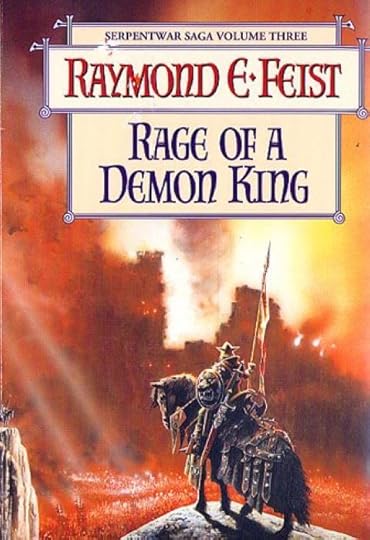Riftwar Re-Read #10 – Rage of a Demon King
Alright, people. It’s time for the actual Serpentwar.
(Just as an aside, I’m currently 4 books ahead of this in the series and taking a pause so I can catch up on reviews before I plough into the next trilogy. But the Conclave of Shadows trilogy will probably just be one big review so not too long before I can press on.)
The board has been thoroughly set. Erik von Darkmoor and his fellow fantasy commandos have gathered all the intelligence they can. Jimmy the Hand, now Duke of Krondor, has been planning the defence of the Kingdom down to the last sword. Roo Avery has (reluctantly) been preparing to fund said defence effort. And all the while, Pug, Miranda, Nakor and the rest of the merry band of immortal magicians have been figuring out just what’s behind the upcoming invasion of the Kingdom from the distant land of Novindus.
Given the title of the book, you may be able to figure that last bit out for yourself.
 Our mysterious warrior has not only gained a shirt, he also appears to have actually stumbled across the plot! The besieged city in the background is, presumably, the besieged Krondor. Huzzah!
Our mysterious warrior has not only gained a shirt, he also appears to have actually stumbled across the plot! The besieged city in the background is, presumably, the besieged Krondor. Huzzah!I’ve also discovered that this cover, and indeed almost all of the Riftwar covers I’ve featured so far, were made by Geoff Taylor, who also painted loads of Warhammer artwork. Nice one, Geoff.
Rage of a Demon King is the part of the Serpentwar that actually covers the Serpentwar itself. There’s been a hell of a lot of setup, but I would definitely say that Rage lives up to the hype, even though by necessity it’s got a lot of moving parts. There are 4 primary POVs – Pug, Erik, Roo and good old Jimmy – as well as a host of other, shorter POVs from various characters both old and new.
With those 4 POVs come 4 main plotlines. Erik is actually fighting the war, Roo is running from it, Jimmy is coordinating it, and Pug is trying to end it at the source before the world gets blown up. It’s a tricky proposition but Feist manages to balance everything very nicely – and because the war is being examined from so many different angles, it becomes an extremely well-realised and described thing. All the death and destruction has meaning, and it comes across well.
The first bit of the book is the last preparation time before the invasion. We get a last glimpse at ‘normal’ life in the Kingdom for our protagonists, which is a very effective way to contrast everything going to hell in the second act. Especially as, while most of the ordinary folk of Midkemia are just getting on with their lives, our protagonists are well aware that the clock is ticking.
We also get reintroduced to some of the other characters who’ve made all this happen from the start – as in, in the earlier Riftwar books. Prince Nicholas, star of The King’s Buccaneer, is now Lord Admiral of the Kingdom fleet, ready to take on the invaders at sea. (In a nice nod to changing times, the Royal Navy is now distinctly Napoleonic in flavour despite everything still being swords and crossbows.) William, son of Pug and one of the protagonists of the infamous Krondor trilogy, is now Knight-Marshal of Krondor and basically in charge of the whole ground defence. A whole raft of other minor characters show up too… and not a lot of them survive.
Because this is a war, and if the much darker tone of the first two books didn’t clue you into what was going to happen when the Serpentwar actually kicked off, then the abrupt death of some characters who’ve been happily living their lives for the last 6 books will certainly do it.
The action is great. Erik von Darkmoor has come a long way from burly teenage murderer. Now he’s effectively one of the top generals in the whole Kingdom, but he’s still leading from the front and getting stuck in. His POV shows us brutal fighting from Krondor back up into the mountains, showcasing a brilliant siege of the city and all the subsequent retreats and last stands. He’s a grizzled veteran – as, by now, are we, having followed all his adventures to this point. He stands in marked contrast to most of the young soldiers around him who don’t even know where Novindus is.
A great counterpoint to Erik’s narrative is given by our wannabe Merchant Prince, Roo Avery. He’s running away from the fighting, but not entirely successfully, and through him we get to see what the poor civilians of Midkemia are subjected to during the invasion. It’s not pleasant, and it provides some fantastically tense scenes – especially when all of Roo’s bad decisions from Merchant Prince inevitably come back to bite him.
Meanwhile, Duke Jimmy and a few other characters are looking at the war from the top down, and despairing as their carefully laid plans are dashed one by one in the face of overwhelming force. Despite two books’ worth of preparation, the armies of the Emerald Queen are still just too strong. Which means falling back on a truly last-resort plan on Jimmy’s part… the nature of which I am loath to reveal, so if you don’t want too many spoilers, look away.
He blows up Krondor. While still inside it. One of my favourite characters, giving his life for the city that made him and the city that he made his own. It’s one hell of a scene, because Krondor has, essentially, been a major character in its own right. The Riftwar may have begun out in Crydee, and until now all its battles have been fought elsewhere. But Krondor was where Arutha ruled. It was where Jimmy the Hand grew up. It was the beating heart of the Kingdom and the plot; almost everyone’s home base, whether in the Prince’s palace or the seedy underground.
Jimmy the Hand is gone, and Krondor with him. And Feist writes it beautifully.
Less beautiful, but still good, is the last strand of the plot, and the one with the grandest, if not the best-realised, stakes. Pug and all the other magicians are standing by to stop the Emerald Queen herself from reaching the Lifestone underneath Sethanon and blowing up the world. Because the Emerald Queen is actually the titular Demon King. (Surprise!) This involves various attempts to fight her with magic – which, for once, fail dramatically, almost killing Pug outright. It’s refreshing to see Pug, who’s been creeping slowly towards godlike power levels, get brutally knocked down a couple of pegs; it reinforces the stakes and makes him a much better character in the aftermath. Even the unstoppable Tomas is very nearly proved stoppable.
(The presence of various demons is also important for setting up the next arcs of the whole series, which start delving into other planes of reality and all sorts of stuff like that – but right now that’s not important.)
The bit I don’t like about this plotline is that it ties up Calis. Throughout the last two books, Calis has been acting as a badass commando captain, leading elite units and generally masterminding the defence of the realm. It’s his plans that Erik is following to defend Krondor, his training that everyone is relying on. But when the actual fighting comes… Calis isn’t there. Because he’s ‘borrowed’ by Pug and company to defend the Lifestone (as, due to Magic Reasons, he’s the only one who can neutralise its power, being part elf, part human and part Dragon Lord). Now, if Calis was actually angry about this, or resisted being co-opted, I wouldn’t mind. Because that would make sense: he’s spent half his life preparing to fight the Emerald Queen, and being taken away from the fighting when he’s most needed would make him absolutely furious. That would be very in keeping with his character. It would have made for a dramatic moment, too, if Pug had to literally pull Calis away from the war to force him to confront his destiny.
But instead, he just… goes along with it. All his badassness just sort of evaporates, and Calis abandons the war he’s trained for for decades without a second thought. And it makes the whole mystical plot feel a bit flat as a result. It saddened me, because it’s a poor use of a really good character. Definitely one of Feist’s low points.
As a last aside, I’m going to have to talk briefly about the Krondor trilogy. Because as I mentioned in my last review, there was an unexpected appearance from a random side character: Lysle Rigger, whose only distinguishing feature was that he looked just like Jimmy the Hand. In the Krondor trilogy, he is ultimately a pointless aside that adds nothing to the narrative at all. But he’s back, and he is very relevant. Because he’s now the head of the Guild of Thieves, and suddenly a pointless aside has become a nice mirror to Jimmy the Hand – now Duke James – and an insight into what might have been, had Jimmy not gotten involved with the main plot back in Magician.
There’s also a great little moment where one of my least favourite things about Krondor is finally paid off. As I mentioned back in my review, several chapters in Betrayal end on a character picking up a magic item and going ‘oh this is cool, I’m sure it’ll be useful later’… and then never using them again. Well, in the middle of Rage of a Demon King, one of those very magic items is finally, finally ‘useful later’. It was a small moment, but I loved it.
In summary (after what’s turned into my longest review yet, I think), Rage of a Demon King delivers on almost all fronts. The Serpentwar has been long in the coming, and though the actual fighting is fairly brief, it’s worth the hype. The Kingdom is left mostly triumphant, but in ruins. Many protagonists gave their lives for it. Plot threads from some of the weakest books in the Riftwar are rendered useful. Despite a few flaws, Feist delivers what must have been a very complex book to write and he does it well.
But while the Serpentwar is over, the Serpentwar is not. There’s one book left. Because the Kingdom is in ruins, and someone has to pick up the pieces.
Jimmy the Hand is dead. Long live the Jim. And the Dash.
(You’ll get it next time, honest.)



